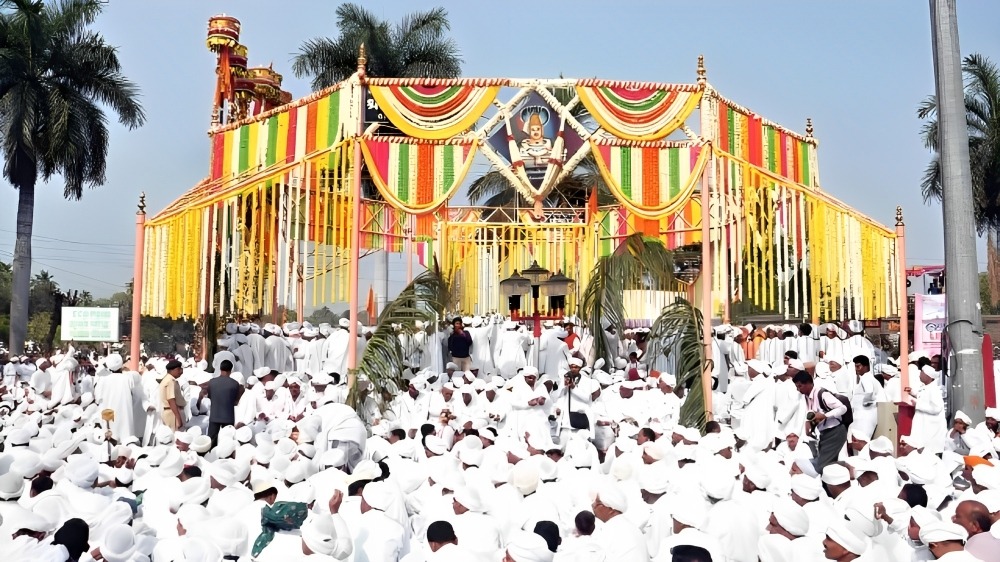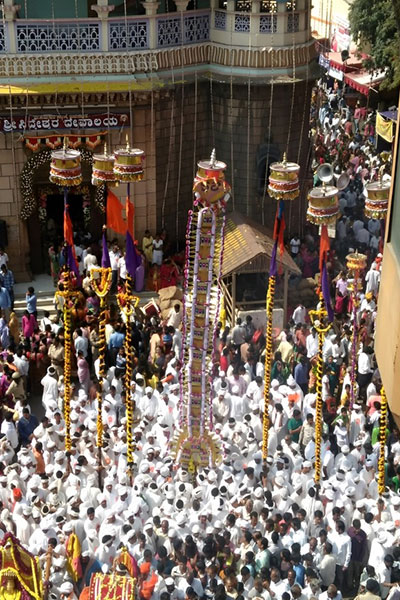

SHRI SIDDHARAMESHWAR GADDA YATRA
Shri Siddharameshwar was a saint of the 12th century whose “Karmyoga” on his own native land-Solapur turned him into a God-figure over the course of time. With the name of Lord Siddheshwara, every year Gadda Yatra is celebrated in the month of January. There is story behind to celebrate the yatra or fair. Inspired by teachings of Lord Siddheshwara, a young girl, Kumbhar Kanya wished to marry him but be denied the offer, instead giving her permission, to marry his yogadanda means yoga-stick. One of the prominent celebrations during this yatra commemorates this wedding, where in the Nandi Dhwajas (decorated bamboo poles) are presumed to be the bridge and groom and taken out in a procession. Some other rituals performed during the festival include Tailabhishek, Akshata, Hom and Fireworks. More than one Lakh of devotees from Maharashtra, Karnataka, Andra Pradesh comes together for the annual Gadda Yatra in Solapur.
The Gadda Yatra is a social gathering which creates communal harmony within the society bringing together people from all religions.

Shri Siddheshwar Devasthan Trust has celebrated centenary festival in 1990. It is one of the oldest charitable trusts in Maharashtra. The sole purpose of the trust is, its incorporation to uplift people from poverty, to empower women, to eradicate illiteracy, to promote public health and comfort, to further religious activities and other charitable work, the trust has been performing all these duties from its establishment year. Being the trustees of this trust, its our responsibility and accountability to carry this legancy forward and do the comprehensive work for the society. So we have following plans, To fulfill the plans, we need kindly help from every corner of the society. Its our kind appeal to all NGOS, Companies, Industries, to give their helping hands by contributing funds.

This yatra consists of procession of Nandidhwaja, Akshata and Homa ceremonies which are performed every year during Makar Sankrant. Every year this yatra is held from 12th to 15th January. The actual function starts from 10th January. A female devotee worshiped and served Sadguru Siddharameshwar for long time. She was daughter of a Lingadhari potter named Gundayya. One fine day Sadguru Siddharameshwar asked her why was she so intensely devoted and what she intended to achieve. She candidly but politely opened her heart to him saying that she wished to attain spiritual salvation by performing marriage with Siddharama.
For Shivayogi Siddharama it was impossible to marry in a worldly manner. However, Siddharama offered his Yoga Danda to her and asked her to marry his ‘Yog Danda’. This symbolical marriage was meant for her spiritualism and truth satisfaction. Considering that she has attained the spiritual salvation and supreme bliss, she thought of discarding her mundane body and leave her soul alone, which has now attained pristine purity.
Hence she plunged into ‘Homa’ (holy fire) as a Sati. These events are observed yearly as Akhata and Homa ceremony. On 10th January, Shete family performs Yoga Danda pooja. Shete family also performs Shri Hirehabbu’s and Habbu’s 'Paad-pooja'.
On 12th January, the first pooja of Nandikol is performed by Shri. Hirehabbu and Shri Deshmukh. On behalf of Government Shri. Deshmukh presents a Aaher to Shri. Hirehabbu. All the Nandikol's are carried to 68 lingas by the devotees. Devotees carry these huge Nandikol’s vertically over their abdomen supporting with hands, so that the top most wide portion of Nandikol floats high up in the sky. Shri. Hirehabbu offers vida (betel leaves wrapped around betel nuts) to all the mankaris near Amrut Linga. After offering oil and haldi by the mankari’s Shri. Hirehabbu performs pooja of each linga, this ritual is known as Yannimajjan.
On 13th January, the ‘Day of Bhogi’, first pooja of Nandikol is performed by Shri. Hirehabbu and Shri. Deshmukh. Then first Nandikol is decorated with ‘Bashinga’ (a ritual of tying strand of flower to the brides and bride-grooms forehead decorated with designs of golden paper) and worshiped in Shri. Hire Habbu’s Waada. Then a grand procession of Nandikol’s (Nandidhwaja’s) and Siddharameshwar’s ‘Palakhi’ is taken through the city. Nandikol’s are carried by thousands of devotees turn by turn. Finally these are brought to the ‘Samati Katta’; which is in the campus of Shri. Siddharameshwar temple. On arrival Shri. Hirehabbu and Shri. Deshmukh perform the pooja of the seven Nandikol’s. Next, ‘Sugadi pooja’ is done by worshiping thirteen Kalasas filled with Gangajal (holy water) followed by Samati pooja. Then Samati is handed over to Shete family by Shri. Hirehabbu and Shri. Deshmukh for reading the Mangalashtak. Then Yoga Danda’s marriage ceremony is performed, this Akshata Sohala is attended by 2-3 lakh devotees. People offer Bashinga and Coconut garlands to the Nandikol’s. At night the yatra returns to Shri. Hirehabbu’s Waada. On 14th January, the Nandikol’s are taken to Shri. Siddharameshwar temple. There the coating of Karmutagi is applied on the Yoga Danda, Gods idol and to all seven Nandikols and then they are given ‘Abhyanga Snana’ (holy water bath).

Next the Ganga poojan is performed and Shri. Hirehabbu offer vida to Shri. Deshmukh. One more pooja vidhi is performed by Shri. Hirehabbu in the main Shri. Siddharameshwar temple. Then the Nandikols are returned to Shri. Hirehabbu’s Waada in the afternoon. In the evening the Nandikol procession starts from Juni Fousdar Chavadi; where the first Nandikol is decorated with a symbol of snake called ‘Nagfani’ and other Nandikol’s are decorated with Bashing’s. Shri. Hirehabbu performs first Nandikol’s pooja and all the honoraries are offered ‘Manacha Haar’. Then a honored person who is fasting on the same day carries the first Nandikol to Homakatta.
There five stems of bajara (pearl millet) are used to create a symbol of the Kumbhar Kanya. She is decorated with shalu and all other soubhagya alankar’s such as vermillion, green bangles, mani, mangalsutra, jodave and bashinga. Next her lap is filled with auspicious items like dates, betelnut, turmeric seeds, coconut, almonds etc. Then Shri. Hirehabbu performs pooja and gives her agni then she is left into Homa. Then five pradakshina’s are done to the Homa-Kund by all the Nandikol’s and then the 'Til Gul' ritual is done at the Shri. Siddharameshwar temple.